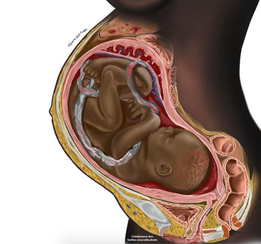 Artist: Chidiebere Ibe Artist: Chidiebere Ibe It seems that by the waning days of 2021, the following statement should be obvious: representation matters. And yet, we continue to be shocked and amazed by the ways in which all are not represented, and the places in which we still see a gaping dearth. If you have a similar Internet algorithm to mine, you have likely seen the new medical illustration going around of a black fetus and pregnant person. The image itself is nothing new: a medical illustration that allows us to understand what is going on beneath the surface of the skin. And yet, when that skin is always white, the sudden visual of a darker expectant patient takes the Internet by storm. Every time I teach a sex education class, I update my slides. I look for any recent research that I should include, look for the latest stats for the location in which I am presenting, and, the most harrowing, search yet again for stock images I can use that represent more than just white bodies. I come up short every time. I talk about this in my lessons now. Because this isn't just about making someone feel “seen” during a lecture, although that too is important; it is about what it means when only white bodies are seen, for generations. Academics talk about something called the social imaginary. It comes from political and moral theorist Charles Taylor, who defines it as “a broad understanding of the way a given people imagine their collective social life” (Duke University Press). I play with this concept when I teach about anything and everything. Easiest way to do so? Type your topic into Google Images and see what comes up. It's a great, if depressing, way to see what we commonly associate with different phrases, labels, and concepts. So when your body is not imagined when we think about “pregnancy,” “mothers,” “parents,” “women's health,” “maternal medicine,” and other vital ways in which we know ourselves and claim the care we need and our roles and meaning in the world... what then? It means we providers give care that does not take into account any unique cultural considerations. It means we providers may hear a person's unique cultural considerations and deem it less worthy or “correct.” It means that we have a staggering maternal health gap in our nation, where Black and Native people are 2 to 3 times more likely to die in pregnancy and childbirth than their white peers. Chidiebere Ibe is the Nigerian medical student who illustrated this new image, and says that Black medical providers are also “more engaged with illustrations that portray their skin color” (BOTWC). The additional mental load of having to look at every image in your medical texts and essentially translate them to understand how they may speak to a body like yours is exhausting. In the case of some skin pathologies, it is also crucial to proper diagnosis. In sex therapy, we are not immune from these oversights and micro-aggressions. Therapists are trained in programs that adhere to white middle class norms, studying mostly white scholars, taught and supervised by mostly white professors. And then, we go into our internships and are often placed in care settings where we practice our new skills on communities of color. Often times, we “pay our dues” in these community mental health and non-profit settings and then move on to private practice where we do not take Medicaid/Medicare, or any insurance at all. It leaves our seasoned professionals out of reach for many BIPOC patients, and allows us to continue working without advancing our education around race and ethnicity. Medical illustrations will not change the health care crisis, or the student debt crisis that pushes many therapists to move away from affordable and accessible clinical care. We literally cannot afford to provide it and pay back our educational costs at the same time. But these images are a call to action, an affirmation of humanity, and a small chip in the current imaginary of what the algorithm tells us it means to be a human being deserving of expert care and respect. To donate to the artist's medical school fund, visit their GoFundMe site here. Sources: Duke University Press CDC BOTWC
0 Comments
|
 RSS Feed
RSS Feed